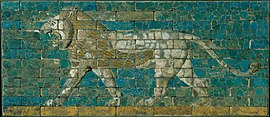| Panel with striding lion | |
|---|---|
 | |
| Artist | Unknown |
| Year | c. 6th century B.C |
| Medium | glaze and paint on molded brick |
| Dimensions | 97.16 cm × 227.33 cm (38.25 in × 89.50 in) |
| Location | Metropolitan Museum of Art |

The Panel with striding lion (MA 31.13.1) is a panel of Neo-Babylonian glazed ceramic bricks or tiles dated to 604–562 B.C., now in the Metropolitan Museum of Art, New York. It was one of many that lined the Processional Way north of the Ishtar Gate. It was excavated by R. Koldewey in 1902, and at the Staatliche Museen zu Berlin from 1926, before coming into the possession of the Met in 1931.
A large group of such figures is part of the Processional Way leading to the Ishtar Gate, a centrepiece display of the Pergamon Museum in Berlin.
Lions were symbolic of royalty because of their strength, and fighting a lion gave a king great prestige. The lion was also the symbol of Ishtar, the goddess of love and war. In her role of the goddess of war she is depicted on a chariot drawn by seven lions with bow in hand
See also
- Striding Lion, a similar panel in Toronto
Notes
- "Panel with striding lion". Metropolitan Museum of Art. Retrieved 25 February 2017
- Glubok, 18
- Striding Lion. #25 of 66 images with description provided on the Royal Ontario Museum website. , retrieved February 25, 2013.
- Guirand, F. 1959. Assyro-Babylonian Mythology, p. 57. In R. Graves (ed.), Larousse Encyclopedia of Mythology, 49-72. London: Paul Hamlyn. 57.
Sources
- Dimand, Maurice. "Two Babylonian Reliefs of Enameled Brick." Bulletin of the Metropolitan Museum of Art, Nr. 26, 1931
- Glubok, Shirley. The Art of Lands in the Bible. New York: Atheneum, 1963